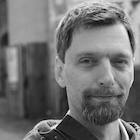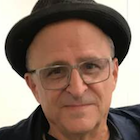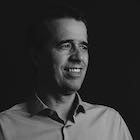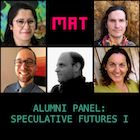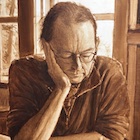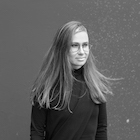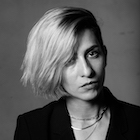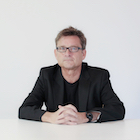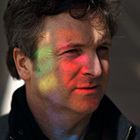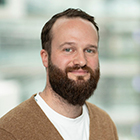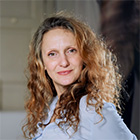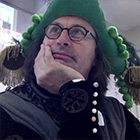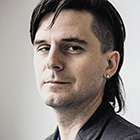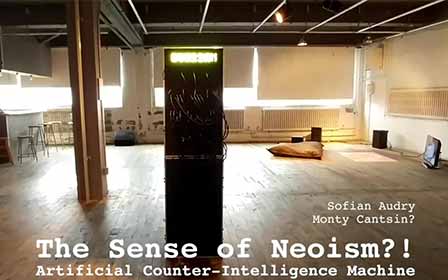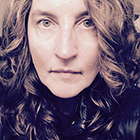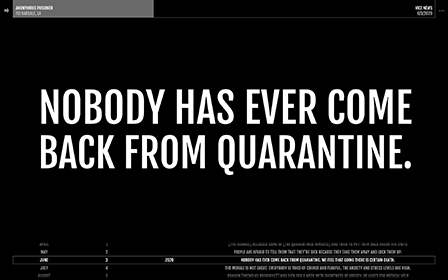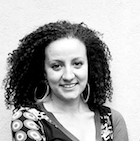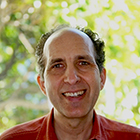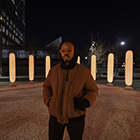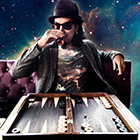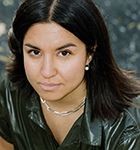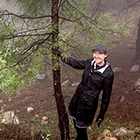MAT Seminar Series 2021 • 2022
Fall 2021
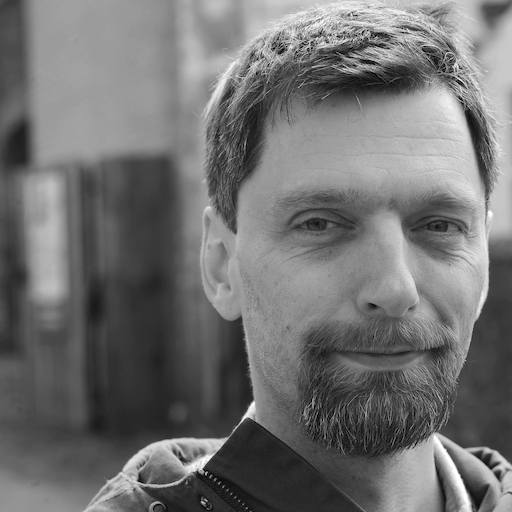
Abstract
This long-running research project started as an attempt to deal with an ancient question: how can we learn something we don't already know? As a possible answer, Joost Rekveld has been exploring the idea that new things can be learned in interaction with devices outside of us. By focusing on the agency of technological artefacts in speculation and creation, his project hopes to contribute to a reflection on technology as something else than a tool to subjugate our planet and ourselves.
Practical work focused on the room full of historic and recent analog computers that has been Rekveld's studio for the past few years. Rekveld has been making artistic works nourished by a form of media-archeology that serves two purposes that are almost opposed; one the one hand seeking to illuminate aspects of current practices by going back to their origins, on the other hand looking at the past as a rich and relatively accessible source of difference. Analog computing is an interesting study case since it is the historical origin of computing as a form of interactive exploration, and because interaction with analog computers is non-symbolical: they are not programmed using code but by adjusting material configurations.
In his presentation, Joost Rekveld will talk about his recent work with analog computers and discuss the roots of still embryonic plans involving evolvable hardware.
Bio
Joost Rekveld explores the sensory consequences of systems of his own design, often inspired by forgotten corners in the history of science and technology. He combines temporary dogma’s in the form of procedures or code with open-ended elements such as material processes or networks of interactions that are too complex to predict. His films, installations and performances are composed documentaries of the worlds opened by such systems. In their sensuality they are an attempt to reach an intimate and embodied understanding of our technological world.
His abstract films have been shown world-wide in a wide range of festivals and venues for experimental film, animation or other kinds of moving image. He had retrospectives at the Barbican in London, Redcat in LA, and the Ann Arbor film festival amongst others, and in 2017 he was filmmaker in focus at the International Film Festival Rotterdam. Individual films were screened at hundreds of venues, including the ICA and the Tate Modern in London, The Centre Pompidou in Paris and the Moderna Museet in Stockholm. His film “#11, Marey <-> Moire” was the first Dutch film ever to be shown at the Sundance Film Festival.
He has realized several installations and was involved in many collaborative projects involving composers, music ensembles, theatre companies, dance companies and artist’s labs. He has been giving lectures since 1993, has been teaching since 1996, and from 2008 to 2014 he was the course director of the ArtScience Interfaculty of the Royal Conservatoire and the Royal Academy of Art in The Hague. Since 2017, Joost has been affiliated to the School of Arts, University College Ghent (Belgium) as an artistic researcher.
www.joostrekveld.net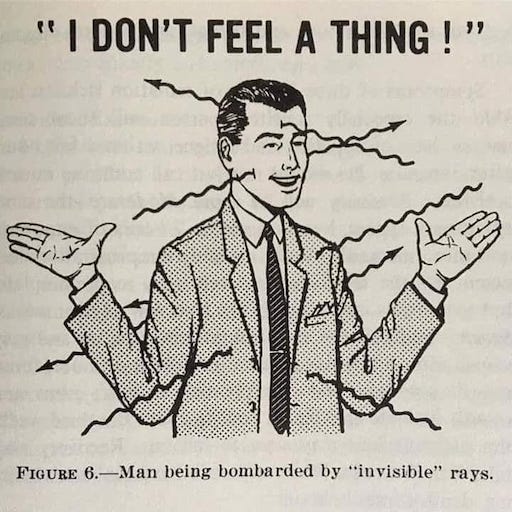
Abstract
Rethinking the cultural dynamics of recent physiology is a means to perceive a new sense, one of two in the eye, one suited to the political conditions of energy. Appealing to mythological and scientific sites of Reverse Icarus, Perdixian technology, Platonic coalescence, the classical elements, and the Holy Trinity of matter-energy-information, this talk focuses on two blues that are not thought to be seen, one in the sky, one in the retina. One occurs in the early days of quantum physics apparent in art and science in European cultural theory; the other grows in significance now that seasons no longer synch with the circadian.
Bio
Douglas Kahn is author of Earth Sound Earth Signal: Energies and Earth Magnitude in the Arts and Noise Water Meat: A History of Sound in the Arts, editor of Energies in the Arts, among other books in histories of the arts, experimental music, and computation in the arts. He is Honorary Professor at Sydney College of the Arts, University of Sydney, and Professor Emeritus at University of California at Davis, and University of New South Wales.
www.unsw.edu.au/staff/douglas-kahn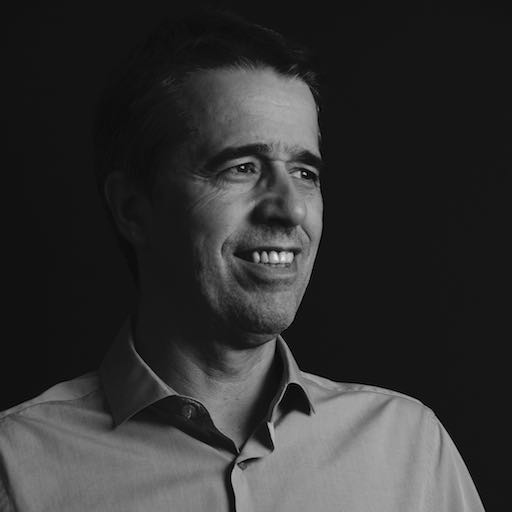
Abstract
This presentation analyses several possibilities of interaction between image movement and sound, under the perspective of gestural and textural relations. Departing from theorists such as Hatten, Smalley, Wishart and Chion, who analyzed the idea of gesture and texture in music, we present several examples from the cinema repertoire (Hitchcock, Lawrence, Kubrick, Reggio, Tarkovski), as well as some author's experimental videos, where specific gestures in the image interrelate with sound/music gestures, in ways that can have multiple meanings, or go beyond the direct translation of one into the other. Gesture will be analysed structurally related to its energetic potential, emotion induction, movement and meaning/metaphor. Other concepts such as causality, energy-motion-trajectory, articulation of a continuum, hierarchical levels and disturbances, analysed by the above-mentioned authors will also be applied to the sound-image relation.
Bio
Composer João Pedro Oliveira holds the Corwin Endowed Chair in Composition for the University of California at Santa Barbara. He studied organ performance, composition and architecture in Lisbon. He completed a PhD in Music at the University of New York at Stony Brook. His music includes opera, orchestral compositions, chamber music, electroacoustic music and experimental video. He has received over 70 international prizes and awards for his works, including three Prizes at Bourges Electroacoustic Music Competition, the prestigious Magisterium Prize and Giga-Hertz Special Award, 1st Prize in Metamorphoses competition, 1st Prize in Yamaha-Visiones Sonoras Competition, 1st Prize in Musica Nova competition. He taught at Aveiro University (Portugal) and Federal University of Minas Gerais (Brazil). His publications include several articles in journals and a book on 20th century music theory.
www.jpoliveira.com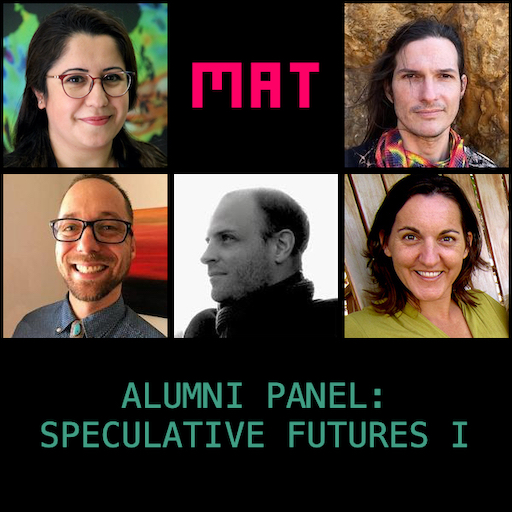
Abstract
Alumni from MAT converse around our special seminar series theme of Speculative Futures (description below) and speak to the field, their retrospectives on the MAT program, their post-MAT work, and where they think the future of the field might be moving (and how this might inform MAT and our future approaches). This MAT Alumni Panel is the first in a series of such alumni panels we plan to hold.
Speculative Futures
The future is inherently unknowable, but our present converging crises make for some particularly mysterious seeding conditions. What futures might emerge? What kinds of vectors might be possible from this historical node? The destabilizing events of the new decade have catalyzed global critical reflection about longstanding systems and institutions, with particular focus on mitigating existential threats and social inequalities. The stakes have never been higher, but present volatilities may offer increased flexibility for radical change. During the lockdown, transdisciplinary arts organizations such as Leonardo, S+T+ARTS, and Digital Futures have been hosting international conversations on reimagining the future and the roles that we, as hybrid practitioners, might play in realizing positive change. Relatedly, the practice of speculative design encourages this genre of critical future ideation through artistic praxis itself. As an extension of these efforts and mindsets, the 2021 Fall MAT Seminar Series invites speakers both inside and outside the media arts field to articulate and share their speculative visions, hopes, and designs for the future in this pivotal time. How might such futures shape our field? How might the field change to better guide better futures?
Bios
Basak Alper Ramaswamy
Basak Alper Ramaswamy works at Jet Propulsion Laboratory NASA. She is a product manager of software tools that are being developed for ground operations of space missions. She applies her skills in user research, data science and visualization to create software tools with a user-centered focus. She received her PhD degree from the UCSB MAT program in 2013. Her research interests spanned information visualization and human-computer interaction topics. She has published in various journals and conferences including ACM SIGCHI, IEEE Transactions on Graphics and Visualization, IEEE InfoVis. She lives in Pasadena CA with her husband and two daughters.
August Black
August Black is a hybrid practitioner of art, design and engineering. He makes experimental spatial and acoustic situations, often by building his own technological artifacts and instruments in hardware and software. His past work focused on live networked audio, mixing FM radio with user input through online software. His current interests span the fields of the philosophy of technology, software studies, techno-politics, peer-to-peer networking and AI/machine learning. In the past, he’s been a member of arts organizations such as the ORF Kunstradio and the Ars Electronica Futurelab, as well as a former member of the engineering team at Cycling ‘74, makers of Max/MSP. He has shown works at festivals and venues such as Ars Electronica Festival, Dutch Electronic Arts Festival, Wave Farm, Transmediale, Pixelache, LA Freewaves, Piksel Festival, Polar Circuit and the Tasmanian Museum of Art, among others. He earned a BFA at Syracuse University and an MS/PhD at UC Santa Barbara. He currently serves as Assistant Professor of Critical Media Practices at CU Boulder.
august.black
Pablo Colapinto
Pablo Colapinto, Head of Immersive at Nexus Studios. Pablo leads the creative and technical development of next-generation XR interactions, behaviors, experiences, games and narratives for innovation-led clients including Disney, Niantic, Google, Facebook, Samsung, Netflix, MLB, NBA, T-Mobile, Verizon, and AT&T. His varied background bridges filmmaking, emerging technologies, product design, computer science, mathematics, and theater. Working closely with directors, researchers, designers, and engineers across industries, Pablo has aligned diverse resources to establish a highly sought-after practice of spatial content production from Nexus' Los Angeles Downtown Arts District office.
Pablo received his PhD in Media Arts and Technology from UC Santa Barbara as a Robert W. Deutsch Foundation Fellow in spatial computing, following a BA in Visual and Environmental Studies from Harvard University as a Mellon Fellow, and a Pew Fellowship in the Arts for his work in experimental animation.Before joining Nexus, he led core graphics platform development at Oblong Industries, an innovative gesture-based spatial start-up founded by the UX designers of Minority Report and adopted by NASA and IBM, amongst others, and was a lead graphics programmer of the Allosphere, a 3-story immersive 3D instrument housed inside the California NanoSystems Institute. His work has been seen at various premiere venues, including Lincoln Center, BAM, and The Metropolitan Opera.
wolftype.com
Enrica Costello
Enrica Lovaglio Costello was raised in an Italian hamlet by the Mediterranean sea. She studied architecture in Genova (Italy), urban design in Lyon (France), and media arts and technology in Santa Barbara (U.S.A.). Enrica is a Full Professor in the Art and Design department with an honorary appointment in the Computer Science department at Cal Poly. In the last two decades, her main interests have included immersive and interactive narratives and cross-disciplinary and cross-cultural explorations through advanced technology. More recently, her research focus has been defining new methodologies to reduce discriminatory bias. For example, she is exploring if collaborations between academia and juvenile correctional systems in designing narratives and experiencing them in virtual reality can lead to an empirical, evidence-based pedagogical method to increase diversity and inclusion inside American universities.
artdesign.calpoly.edu/faculty-staff/enrica-lovaglio-costello
Sterling Crispin
Artist and technologist born 1985 in Maui, Hawaii. His work has been exhibited in museums and galleries worldwide, and in The NYT, Frieze, Wired, BOMB, Rhizome, ARTNews, Art in America, Fast Company.
sterlingcrispin.com
Abstract
I will discuss various projects I have worked on over the last ten years involving user interface, audio synthesis code generation, and language design in pursuit of some long term goals I have for an audio synthesis and music composition system.
Bio
James McCartney studied computer science and electronic music at the University of Texas at Austin. He wrote music for various dance and drama productions in Austin, and later developed the SuperCollider programming language for audio synthesis and algorithmic composition. For a few years he worked on the Hubble Space Telescope project on software for observation planning and data analysis. He worked for 16 years at Apple in the CoreAudio group. Now he is retired and pursuing further interests in possibilities for audio synthesis environments.
supercollider.github.io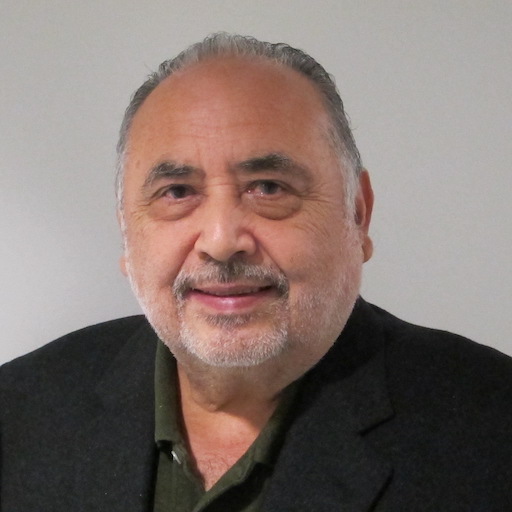
Abstract
Our notions of human learning and cognition in the learning sciences are undergoing sweeping changes as we better grasp the relationships between human’s embodied mental construction and interpretation of everyday reality and its relationship to the material world, society, and culture. I review Chalmer’s notion of extended mind and the notion of situated cognition as examples, with updated concern for how ubiquitous computing design and related technologies have become widespread as resources for edge scientific advances, literacy learning, culture creation, and expression. I call attention to the importance of calling attention of these developments to young people underserved by the education system and society at large.
In light of these concerns, I review efforts to introduce ubiquitous computing into expansive learning activities conducted by immigrant Latinx youths in a maker space at the St. George Youth Center in Isla Vista.
Bio
Richard Durán is a professor in the UCSB Gevirtz Graduate School of Education. His research interests include notions of extended mind and computational thinking from a learning sciences perspective and how we can pursue equity and affirmative development of persons from underserved communities enabled by collaboration and inventive use of technological tools.
education.ucsb.edu/research-faculty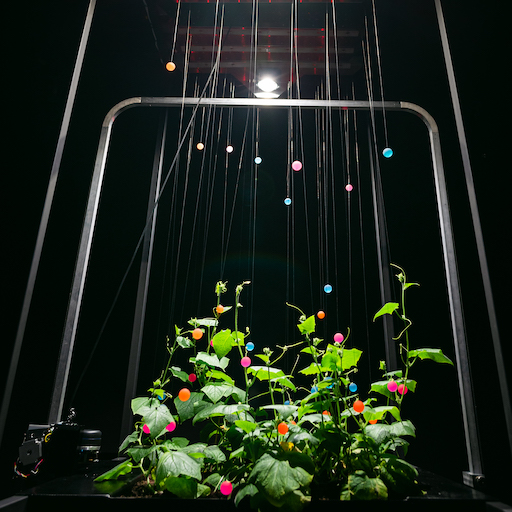
Abstract
The PLANT-MACHINE is the umbrella title for an art practice and research through which Špela Petrič examines the entwinement of advanced technologies with living bodies, positing horticulture as a model of these relations. By experimenting with ways to appropriate or subvert data acquisition and processing methods, the projects question the current use of algorithms. In the context of the artworks, data becomes the raw material for non-utilitarian, speculative representations of plant life in the sphere of information.
Bio
Špela Petrič is a Ljubljana and Amsterdam based new media artist who has been trained in the natural sciences as well as transmedia arts. Her artistic practice combines technolgoy, wet biomedia practices, and performance. She is currently working as a researcher at the Vrije Universiteit Amsterdam, studying how automation of care manifests in various spheres, from horticulture to human medicine. Petrič received several awards, such as the White Aphroid for outstanding artistic achievement (Slovenia), the Bioart and Design Award (Netherlands), and an Award of Distinction at Prix Ars Electronica (Austria).
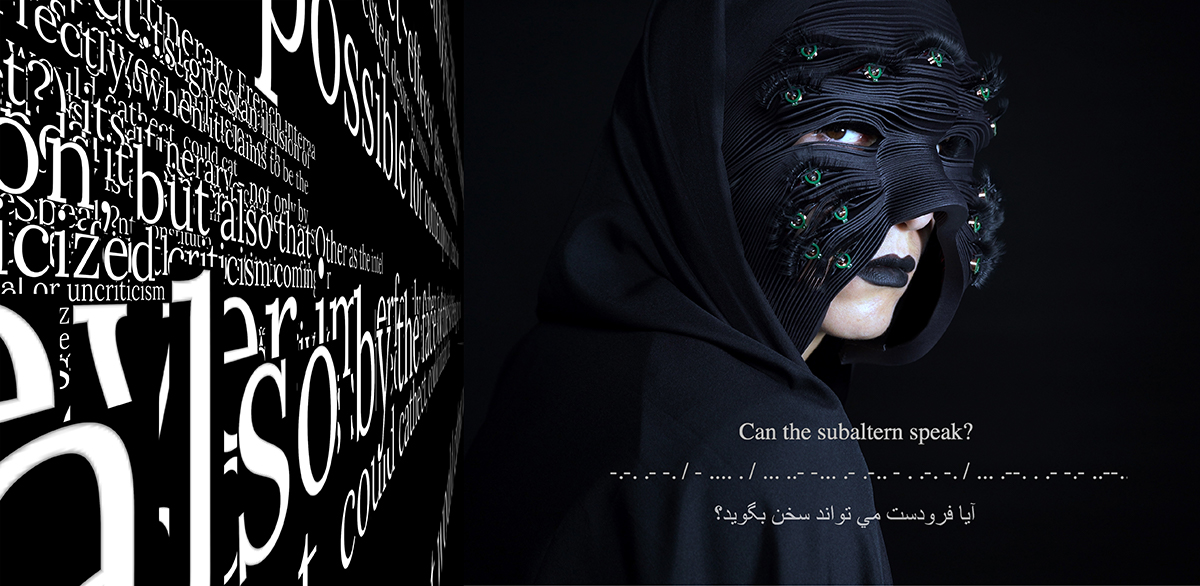
Abstract
Can computation be critical or will various forms of bias always be found embedded in computational systems? Could surveillance act as a form of resistance? Could materials be imbued with Artificial Intelligence and computer vision in order to address critical issues such as emotion? The goal is to address the possibility of an empathetic relationship between human beings and their environment in order to augment human intelligence and sensory experience of the world and influence social interactions in a critical way. By demonstrating a series of interdisciplinary projects, the attempt is to address provocative research questions through design and critical making, fueled by the latest advances in the world of neuroscience, cognitive philosophy, computational design, artificial intelligence and feminism. From wearables to architecture, these projects demonstrate an application of techniques, such as EEG brain imaging, facial and gaze tracking as well as novel actuator systems, such as smart materials and pneumatics systems.
Bio
Trained as an architect, Behnaz Farahi is an award winning designer and critical maker based in Los Angeles. She holds a PhD in Interdisciplinary Media Arts and Practice from USC School of Cinematic Arts. Currently she is an Assistant Professor at the Department of Design, California State University, Long Beach. She explores how to foster an empathetic relationship between the human body and the space around it using computational systems. Her work addresses critical issues such as feminism, emotion, perception and social interaction. Farahi has won several awards including the Cooper Hewitt Smithsonian Design Museum Digital Design Award, Innovation By Design Fast Company Award, World Technology Award. She is a co-editor of an issue of AD, ‘3D Printed Body Architecture’ (2017) and ‘Interactive Futures’ (forthcoming).
behnazfarahi.com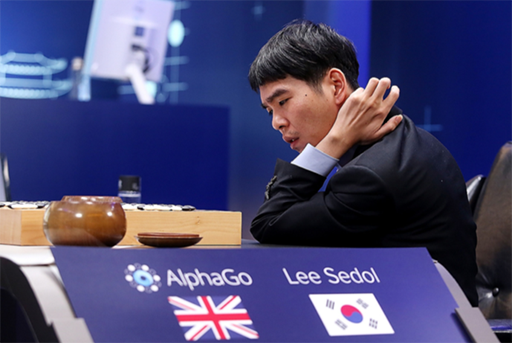
Abstract
‘The ideas that are driving AlphaGo are going to drive our future.’
AlphaGo documentary
‘AlphaGo showed us that moves humans may have thought are creative were actually conventional.’
Lee Sedol, following match with AlphaGo
‘Overnight, China plunged into an artificial intelligence fever. . . AlphaGo was China’s Sputnik moment.’
Kai-Fu Lee
Seldom has a game had such a profound impact on the world. In 2016 a match of Go took place between leading Korean Go player, Lee Sedol, and AlphaGo, an AI program developed by DeepMind of London. Few had expected AlphaGo to beat one of the world’s leading Go players, given the complexity of a board game where there are more potential moves than atoms in the universe. But AlphaGo comfortably beat its human opponent. Moreover, AlphaGo played a series of strategically brilliant moves never seen before. The match transformed the game of Go forever, but its overall impact was felt even more broadly. AlphaGo had demonstrated that AI could out perform human beings at a highly complex challenge, and caused a seismic shock – a wakeup call – for China and Korea, two countries where Go is a national game, prompting both countries to invest heavily in AI research.
How will the ideas behind AlphaGo – and AI in general – transform the discipline of architecture? Learning from AlphaGo draws comparisons between the ideas behind AlphaGo and the startling ways in which AI is already being used to transform the profession: AI is automatically generating novel architectural designs, and outperforming architects in urban planning; AI is controlling our environmental systems and sorting out all our traffic jams; AI is teaching robotic arms to stack bricks and build walls; and clients have even begun to insist on architects using AI to guarantee their return on investment. The AI revolution has already begun.
In 1972 Robert Venturi, Denise Scott Brown and Steve Izenour published Learning from Las Vegas. 50 years later, it is clear that AI is going to transform architecture more radically than Las Vegas ever could. It is now time to learn from AlphaGo.
Bio
Neil Leach is a British architect and professor. He currently teaches at FIU, EGS and Tongji, and taught previously at AA, Harvard GSD, Columbia, Cornell and SCI-Arc. He has been a NASA research fellow, developing 3D printing technologies for the Moon and Mars, and is an academician within the Academy of Europe. He has published over 40 books on architecture and digital theory. His books include Rethinking Architecture (Routledge, 1997), Designing for a Digital World (Wiley, 2002); Digital Tectonics (Wiley, 2004); Camouflage (MIT Press, 2006); Digital Cities (Wiley, 2009); Space Architecture (Wiley, 2014); Swarm Intelligence (TongjiUP, 2017); Computational Design (TongjiUP, 2017); Digital Fabrication (TongjiUP, 2017); Architectural Intelligence (Springer, 2020); Material Intelligence (Springer, 2021); Architecture in the Age of Artificial Intelligence (Bloomsbury, 2021) and Machine Hallucinations: Architecture and AI (Wiley, 2022).
neilleach.wordpress.comWinter 2022
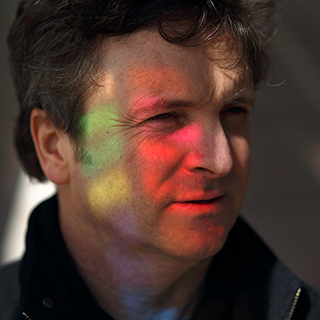
Abstract
A talk by internationally recognized artist Marcos Lutyens covering the trajectory of his work that centers around consciousness. His emergent work spans neuroscience, shamanism, performance art, hypnosis, networked video, augmented reality, and various other art forms, seeking to expand what we consider to be the roots of consciousness.
Bio
In his explorations of consciousness, Lutyens has collaborated with celebrated neuroscientists V. Ramachandran and Richard Cytowic, as much as studying under shamans from different cultures. His works take form in installations, sculptures, drawings, short films, writings, and performances. Lutyens has exhibited internationally in numerous museums, galleries, and biennials, including the Royal Academy of Arts, Centre Pompidou, National Art Museum of China, Documenta, and the Biennials of Venice, Istanbul, Liverpool, São Paulo.
www.lutyens.comSee video recording of the talk here
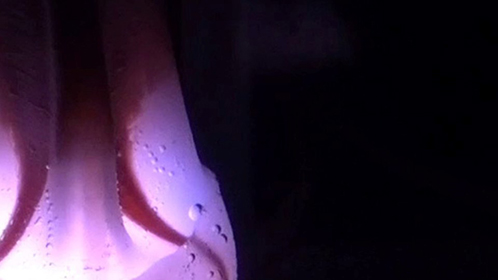
Abstract
Soft Robotics designates a novel approach to designing robots anchored in the simple idea of using compliant structures and elastic materials rather than rigid metal or plastic parts. In this seminar talk, I introduce the research and creation program of Soft Robot Aesthetics that seeks to unite interests and methodological approaches drawn from artistic research, art history, human-robot interaction, and technical soft robotics research. The broad overall aim of this body of work is to explore alternative versions of what soft robotics might be or become if approached from the point of view of art and aesthetics, and how a more nuanced understanding of the potentials and consequences of rendering a robot soft can be attained through aesthetic practices. The talk describes selected work done at the Center for Soft Robotics at the University of Southern Denmark, including our ongoing collaboration with Maja Smrekar on the final chapter of the !brute_force series. Through methodological considerations and reflections on case study projects, I aim to illustrate how artistic and aesthetic perspectives may generate distinct types of questions and insights about soft robots, as well as singular outcomes, of which some are useful for robotics research more broadly.
Bio
Jonas Jørgensen is Assistant Professor at the Center for Soft Robotics at the Biorobotics section of the University of Southern Denmark. Jonas was originally trained as a physicist (BSc) and an art historian (BA, MA) at Univ. of Copenhagen and Columbia University (New York). He received a Ph.D. degree at the IT University of Copenhagen as a member of the Robotics Evolution and Art Lab (REAL). Jonas’s research and practice span the fields of robotic art, soft robotics, human-robot interaction, and media art history. He has presented papers and organized workshops at several high-ranking international conferences and is the author of more than 20 peer-reviewed publications. With different collaborators, Jonas has created robotic art projects that have been exhibited internationally at institutions including Ars Electronica (Linz, Austria), Chronus Art Center (Shanghai, China), and Science Gallery Dublin. Jonas currently serves as a management committee member representing Denmark in the EU COST action CA18136 “European Forum for Advanced Practices” (2019-2023) that focuses on emerging practice-based transdisciplinary practices. Together with Maja Smrekar, he is also a partner in the EU’s STUDIOTOPIA program.
jonasjoergensen.org/See video recording of the talk here
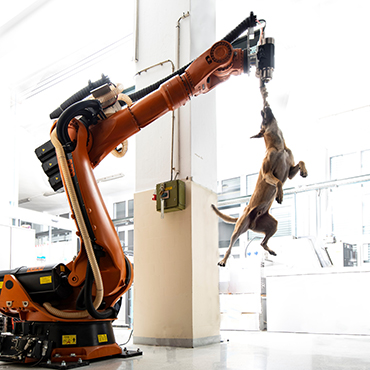
!brute_force (2019). Photo: Borut Peterlin.
Production: Quo Artis Foundation (ES).
Co-production: The Culture Yard (DK) and Kapelica Gallery (SI).
Abstract
Artist talk on Maja Smrekar’s work that derives on an interdisciplinary artistic research, exploring intersections between the human and the animal and intertwines these contexts with technology. Her work stems from the premise that human life is above all, about other than human entities that disrupt the division into subject and object. In her attempts to challenge these relations, she establishes contexts beyond the laws of genus and species or race or gender, constructing situations that happen on a (micro-)political level and furthermore on a molecular one. Drawing inspiration from different media, including performative elements, such as durational and photo performance; Smrekar extends her work into micro performativity that emphasizes on the processes within the human body and also includes nonhuman subjectivities.
Bio
Smrekar's work has been established in the international art and science milieu. Her projects explore the potentials of technologically and scientifically rooted processes and materials, such as from biotechnology, molecular biology, reproductive biomedicine, ecology, ethology, artificial intelligence, soft robotics, etc. Her practice has allowed her to lead strong collaborations in developing productions that include cross-conceptual staging of hybrid art, performance, installations, site-specific, and video as well as contributions to knowledge exchanged within lectures, talks and texts. She exhibited in the following spaces: ZKM Karlsruhe (Germany), Hyundai Motorstudio Beijing (China), MAXXI - National Museum of 21st Century Art in Rome (Italy), Zuercher Gallery / Frieze New York (USA), RMIT Gallery Melbourne (Australia), etc. and festivals: Ars Electronica (Linz, Austria), Click festival (Elsinore, Denmark), Transmediale (Berlin, Germany) ... In 2017 she was the recipient of the Prix Ars Electronica - Golden Nica 2017 in the Hybrid Arts Category (Linz / Austria).
www.majasmrekar.orgSee video recording of the talk here
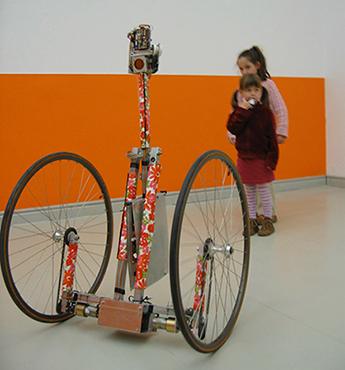
Petit Mal (2007) Wolfgang von Kempelen Media Arts and History.
Photo: Simon Penny.
Abstract
This presentation will focus on my research into distributed, inactive, and embodied cognition as it relates to the arts, and on my critical interrogation of computing history and rhetoric - all of which has arisen out of, and in parallel with, my practice as an artist in interactive, robotic and virtual media. The presentation will begin with an introduction to two works, followed by a discussion of the philosophical ideas that have informed computing and the mind. Questions will gravitate around the issues raised during the presentation and around the two assigned papers: One examines the history of digital media arts in the 90s, the other addresses issues of cognition related to contemporary digital media.
Bio
Simon Penny is an artist, theorist, and teacher with a longstanding focus on emerging technologies and on embodied and situated aspects of artistic practice. He has built interactive installations and robotic art since the mid-1980s. He explores - in artistic and scholarly work and in technical research - problems encountered when computational technologies interface with cultural practices. His longstanding concern for embodied and situated aspects of aesthetic experience, along with a critical analysis of computer culture, is the focus of his book Making Sense: Cognition, Computing, Art and Embodiment (MIT press 2017). He was director of A Body of Knowledge: Embodied Cognition and the Arts conference UCI 2016, and An Ocean of Knowledge: Pacific Seafaring, Sustainability and Cultural Survival at UCI in 2017. He is co-director of the Industrial Crafts Research Network. He was Professor of Art and Robotics at Carnegie Mellon (1993-2000). He founded the Arts Computation Engineering (ACE) graduate program at the University of California Irvine, 2001-2012. He was visiting professor in media theory, Cognitive Systems, and Interactive Media masters, University Pompeu Fabra, Barcelona, 2006-2013, and Labex International Professor, University Paris8 and ENSAD in 2014. Penny is currently a professor in Electronic Art and Design (Dept of Art) at the University of California, Irvine, with appointments in the dept of Music and in Informatics (School of Information and Computer Science). He is a guest professor at the School of Art and Design, Nottingham Trent University UK, 2021-2024.
simonpenny.netSee video recording of the talk here
Abstract
A talk by transdisciplinary artist-researcher Sofian Audry on machine learning art and its practice in new media art and music, presenting as an overview of Audry's new book at MIT Press.
Bio
Sofian Audry is an artist, scholar, Professor of Interactive Media within the School of Media at the University of Quebec in Montreal (UQAM) and Co-Director of the Hexagram Network for Research-Creation in Art, Culture and Technology. Audry's work explores the behavior of hybrid agents at the frontier of art, artificial intelligence, and artificial life, through artworks and writings. Audry's book Art in the Age of Machine Learning examines machine learning art and its practice in art and music (MIT Press, 2021). Their artistic practice branches through multiple forms including robotics, installations, bio-art, and electronic literature.
sofianaudry.comSee video recording of the talk here
Abstract
In the 15th century, Venetians invented Quarantine as a protection against the plague. In the Mid-20th century, Americans invented a criminal punishment system based on the model of Quarantine in which the disproportionately poor, Black, or Brown ‘offender” is treated as a pathogen to be isolated and contained. In the 21st century, COVID-19, an actual pathogen, has both exposed and intensified the brutality of that system — prisoners have been stranded in quarantine without adequate food or medication, abandoned and unseen. In the US over 2 million people are confined in overcrowded, unsanitary, and unsafe environments. Prisoners cannot practice social distancing or use hand sanitizer and are regularly subjected to medical malpractice and neglect. In this seminar presentation, I will focus on the interactive documentary EXPOSED, which provides a cumulative public record and evolving history of the coronavirus pandemic’s impact on incarcerated people. EXPOSED, documents the spread of COVID-19, over time, inside prisons, jails, and detention centers across the US, from the perspective of prisoners and their advocates. Original interviews, along with quotes, audio clips, and statistics collected from a comprehensive array of online publications and broadcasts, are assembled into an interactive timeline that, on each day, offers abundant testimony to the risk and trauma prisoners experience under coronavirus quarantine. The scale of the project is intended to reflect the scale of the crisis. There are now over 11,000 entries in the project database. The monochrome, image-less, headline-styled interface, which allows viewers to step through thousands of prisoners’ statements, is designed to visualize their collective suffering and signal that the injustices they endure are structural.
Bio
Sharon Daniel is a media artist who creates interactive and participatory documentary artworks addressing issues of social, racial, and environmental injustice, focusing principally on mass incarceration and the criminal legal system. She develops innovative online interfaces and multi-media installations that visualize and materialize the testimony of incarcerated people. Her work has been exhibited in museums and festivals internationally. Her work has been honored by the Webby Awards, a Rockefeller/Tribeca Film Festival New Media Fellowship, and a Fulbright Fellowship. She was named in the Yerba Buena Center for the Arts “YBCA 100” – a list of “the creative minds, makers, and pioneers that are asking the questions and making the provocations that will shape the future of American culture.” Daniel is a Professor of Film and Digital Media at the University of California, Santa Cruz.
sharondaniel.netSee video recording of the talk here
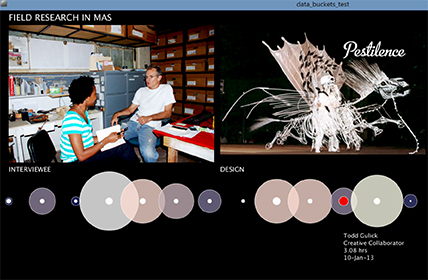
Abstract
Craft practices, knowledges, and communities are disappearing. These practices carry with them histories and cultures of people, knowledges, and social ties to communities. Some reasons for their disappearance include dying practitioners, lacking pedagogy, changing practices, and technocentric developments. How might we employ computation in the restoration, remediation, and reconfiguration of these practices, knowledges, and communities? Additionally, how might knowledges and innovations in these crafts, repair problems and improve research, practice, and pedagogy in computational design? This presentation will share my research into craft and computation such that our field touches the ground, communities, and critically considers access.
Bio
Vernelle A. A. Noel, Ph.D. is a design scholar, architect, artist, and Founding Director of the Situated Computation + Design Lab, which is an interdisciplinary research lab at the intersection of computer science, design, engineering, art, and architecture. Currently an Assistant Professor in the School of Architecture and the School of Interactive Computing, her research examines traditional and automated making, human-computer interaction, interdisciplinary creativity, and their intersections with society. She builds new expressions, tools, and methodologies to explore social, cultural, and political aspects of computational design, and emerging technologies for new reconfigurations of practice, pedagogy, and publics. Her work has been supported by the Graham Foundation, the Mozilla Foundation, and ideas2innovation, among others, and she is a recipient of the 2021 DigitalFUTURES Young Award for exceptional research and scholarship in the field of critical computational design. Dr. Noel has been a Visiting Professor, researcher, and educator at the Cluster of Excellence in Computational Design (IntCDC) at the University of Stuttgart, the University of Florida, Penn State, MIT, the Singapore University of Technology & Design, and has practiced as an architect in the US, India, and Trinidad & Tobago.
vaanoel.com/Situated Computation + Design Lab
See video recording of the talk here
Spring 2022
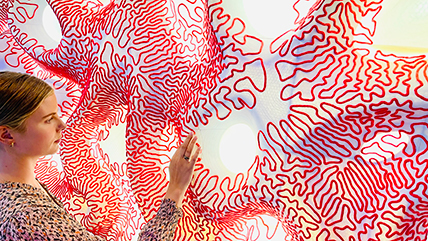
Abstract
The exploration of the public domain is an important parameter to define how we live as collective and how we can rethink the fundamentals of living. The public realm is an expanded field where the deployment of collective ecologies is inherently connected to the socio-cultural production of space and forms of cohabitation of living systems. The talk addresses the intersection of technologies with the public/social/cultural realm through prototyping, material and fabricated systems, data-driven protocols, and mediated environments. Starting from Aério, an installation recently exhibited at the 17th Venice Architecture Biennale, a series of projects will be the vehicle to speculate on the current and future states of socio-technical apparatuses, interlaced ecosystems, and planetary entanglements.
Bio
Marcella Del Signore is an architect, urbanist, educator, scholar, and the principal of X-Topia, a design-research practice that explores the intersection of architecture and urbanism with technology and the public, social and cultural realm. She is an Associate Professor and Director of the MS. in Architecture, Urban Design at New York Institute of Technology, School of Architecture and Design. Her research focuses on interscalar design approaches that engage the notion of socio-technical systems through computation, prototyping, material and fabricated assemblies, data-driven protocols, and adaptive environments. Her work investigates architecture, environments, and cities not as isolated entities but as part of an extended field mediated through the discursive application of technology. In her design practice, she has built a wide array of urban interventions and small-scale prototypes recognized through awards, grants, and publications. In 2018, she co-curated the ‘Data & Matter’ exhibition at the ECC during the 2018 Venice Architecture Biennale, and in 2021 she exhibited “Aério” at the 17th Venice Architecture Biennale. She also exhibited her work at the Gardiner Museum, Ogden Museum of Southern Art, MIT Media Lab, Columbia University Buell Center, Rotterdam Biennale of Architecture, Arte Sella, Milan Design Week, Zero1 Biennal, Brooklyn Navy Yard, Duncan Plaza, Architekturzentrum Wien, EME3, and a series of festivals including LunaFete, Urban Prototyping, DesCours, Think Town, Northern Spark, Verdecoprente, and Conflux among others.
See video recording of the talk here
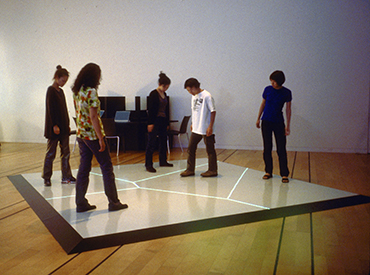
Abstract
Scott Snibbe will talk about three decades of interactive art that connect people through augmented reality, interactive apps, and embodied social interaction. He’ll touch on the uneasy adoption of interactive art techniques into corporate products, and the way digital art can connect us to others, help us better know ourselves, and even respect respecting privacy in the age of the surveillance state
Bio
Scott Snibbe is a pioneering interactive artist, augmented reality entrepreneur and the host of the meditation podcast A Skeptic’s Path to Enlightenment.
Snibbe’s interactive art installations have been incorporated into concert tours, museums, and airports; and he has collaborated with musicians and filmmakers including Björk, Philip Glass, Beck, and James Cameron. His work can be found in the collections of New York MoMA, the Whitney Museum of American Art, and other institutions.
Snibbe has produced several bestselling mobile apps including Gravilux and the world's first “app album” Björk: Biophilia, and was one of the early creators of the special effects animation software Adobe After Effects.
See video recording of the talk here
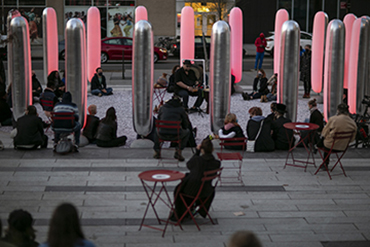
Ekene Ijeoma's photos by Kris Graves
Abstract
Ekene will share how he works across his studio and lab practices to address social issues through various mediums and scales.
Bio
Ekene Ijeoma is an artist who focuses on the overlooked or shared aspects of sociopolitical trends and interpersonal dynamics through the lenses of personal observation and analytical exploration. He works across various mediums including sound, video, sculpture, installation, and performance. His work has been exhibited and performed at Bemis Center for Contemporary Art (2021), Contemporary Art Museum of St. Louis (2021), Museum of Contemporary Art Denver (2020), Contemporary Art Museum of Houston (2020), The Kennedy Center (2019, 2017), Museum of the City of New York (2019, 2018), Neuberger Museum of Art (2016), Storefront for Art and Architecture (2015) and Museum of Modern Art (2015) among others. His practice has been supported by grants and fellowships, including The New York State Council on the Arts (2021); Creative Capital (2019); Map Fund (2019); The Kennedy Center (2017); and New York Foundation for the Arts (2016) among others.
Ijeoma is a first-generation Nigerian-American born and raised in Fort Worth, TX. He lives and works between his studio in Brooklyn, NY, and lab in Cambridge, MA. He earned his BS in Information Technology at Rochester Institute of Technology in 2006 and MA in Interaction Design from Domus Academy (Milan, IT) in 2008.
He is an Assistant Professor of Media Arts and Sciences at Massachusetts Institute of Technology and the Founder and Director of the Poetic Justice Group at Media Lab. Currently, his work with Poetic Justice Group focuses on how art can address the scale of sociopolitical issues through multisite participatory public artworks. These works are accessible over the phone, online, and soon on the streets.
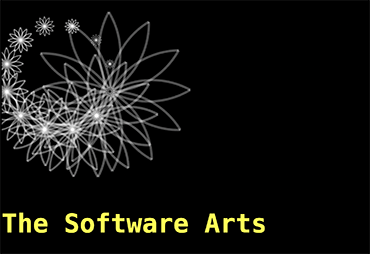
Abstract
Miniatures, demos and artworks (MDAs) are three kinds of software produced in universities, research laboratories, and the art world. Primarily they are created for teaching, arguing, selling, and sparking the imagination to show a larger public what is possible for the future of software. The most well-known miniature is Minix developed by Andrew Tanenbaum (Vrije Universiteit Amsterdam) to teach students about the workings of the Unix. “The mother of all demos” was produced in 1968 by Douglas Engelbart (SRI) introducing the computer mouse, resizable windows, teleconferencing, hypertext, word processing, and collaborative editing — and basically everything we have today in personal computing. The best-known software artwork is probably Spacewar!, a computer game created by Steve Russell in collaboration with several others at MIT in 1962. In this talk I will describe how MDAs are similar and different from one another, have been used and abused in imagining the future of software. Examples include those from the Yale AI Project of the 1980s (where the design of miniatures was a vital concern); demos from the MIT Media Laboratory of the 1990s (an agonistic environment of “demo or die”); and contemporary artworks from the Whitney Museum of American Art, NYC.
Bio
Warren Sack is a media theorist, software designer, and artist whose work explores theories and designs for online public space and public discussion. He is Professor of the Software Arts in the Film + Digital Media Department at the University of California, Santa Cruz where he teaches digital arts and digital studies. He has been a visiting professor in France at Sciences Po, the Fondation Maison des sciences de l'homme, and Télécom ParisTech. His artwork has been exhibited by SFMoMA (San Francisco), the Whitney Museum of American Art (New York), the New Museum of Contemporary Art (New York), the Walker Art Center (Minneapolis), and the ZKM (Karlsruhe, Germany). His scholarship and research has been supported by the Paris Institute for Advanced Study, the American Council of Learned Societies, the Sunlight Foundation, and the National Science Foundation. Warren received his PhD from the MIT Media Lab and was an undergraduate at Yale College. More about his 2019 book, The Software Arts (MIT Press) can be found at http://softwarearts.info
See video recording of the talk here
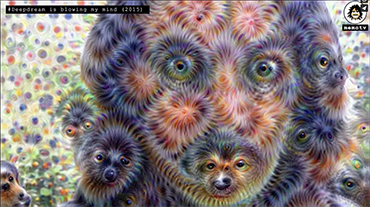
Abstract
In this talk, Memo discusses the conceptual motivations behind some of his recent works and research involving computational technologies, with a focus on artificial intelligence and machine learning, embodied interaction, and mixed reality. From a practical perspective, this includes explorations in real-time, interactive computational systems for artistic, creative expression; and 'intelligent' systems for human-machine collaborative creativity. From a more conceptual perspective, this involves investigations into how we make sense of the world and project meaning onto noise; and more broadly speaking, the collisions between nature, science, technology, ethics, ritual, tradition and religion; particularly in the context of the current social and political polarizations, moral crises and technological submission.
Bio
Memo Akten is a multi-disciplinary artist, experimental filmmaker, musician and computer scientist from Istanbul, Turkey. He works with emerging technologies and computation as a medium, to create images, sounds, films, large-scale responsive installations and performances. Fascinated by trying to understand the nature of nature and the human condition, he draws from fields such as biological and artificial intelligence, computational creativity, consciousness, neuroscience, physics, biology, ecology, philosophy, ritual and religion. He has a PhD in Artificial Intelligence and expressive human-machine interaction from Goldsmiths University of London, and is Assistant Professor of Computational / New Media Art at University of California, San Diego (UCSD). Akten is a frequent keynote speaker on topics involving art, science, technology and culture. As part of his PhD, he specializes in expressive human-machine interaction and creative explorations of Artificial Intelligence, and in this field he is considered one of the world’s leading pioneers.
Memo's Web Site
See video recording of the talk here
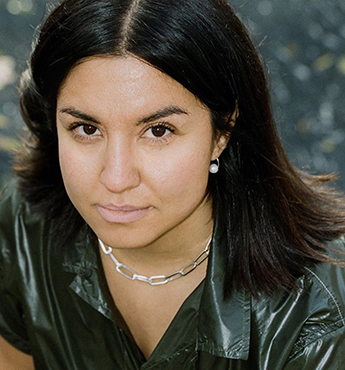
Photo by Chistian Werner.
Abstract
2020 marked an entry into a new era signifying a powerful moment to support aesthetic and political engagements in life sciences and ecology. With rapid advances made in biotechnologies and instruments in perception & sensing technology, artists and designers are an increasingly important voice in shaping how such technologies get rendered at societal level. From ecological awareness around climate change, ethics of geo-engineering, creation of sensing systems, providing glimpses into techno-biological futures, to making with a multitude of species and living systems, the creative inquiry explores the poetic entanglements of living systems & contextualizes conceptually our everyday living. This talk explores sheri’s on-going research & investigation in life sciences through artistic intervention & critical inquiry.
Bio
Yasaman Sheri is a Design Director, Artist & Researcher investigating human relationship to biology & technology and the creative inquiry into life sciences. Her artistic and critical practice explores the plurality of senses and sensing, perception and the invisible scales at which humans frame and reframe ecology through culture, society and technology. She is the founder and Principal Investigator of Serpentine Galleries Synthetic Ecologies Lab and also an educator and design leader with more than a decade of experience in building platforms and novel interfaces in mixed reality and immersive computing as well as life sciences. Yasaman is passionate about sharing her expertise and continues to uplift women identifying communities of color and folks less represented.
Yasaman Sheri's Web Site
See video recording of the talk here
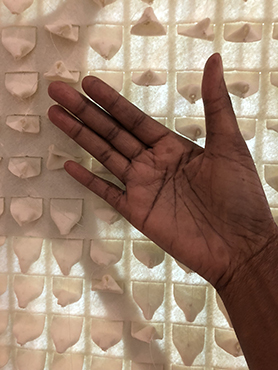
Abstract
Touch of a computational textile on human skin provides a unique opportunity to look at relationships between ambience, emotion and computing. The sense of touch on human skin offers a potential framework to think about ambient computing as the information from skin is multimodal and comes in many forms such as temperature, humidity, sharpness, smoothness, location and movement. Because textiles surround and shelter people in every culture on the planet, they are a culturally embedded and potentially invisible way to create interfaces for people to capture or receive information in ways that engage other senses such as touch. The author of this talk will share work that examines communication of emotion by touch and implications for design computing.
Bio
Felecia Davis’ work in computational textiles questions how we live and she re-imagines how we might use textiles in our daily lives and in architecture. Davis is an Associate Professor at the Stuckeman Center for Design Computing in the School of Architecture at Pennsylvania State University and is the director of SOFTLAB@PSU. She completed her PhD in Design Computation at MIT. Davis’ work in architecture connects art, science, engineering and design and was featured by PBS in the Women in Science Profiles series. Davis’ work was part of the MoMA’s exhibition Reconstruction: Blackness and Architecture in America. She is a founding member of the Black Reconstruction Collective a not-for-profit group of Black architects, scholars and artists supporting design work about the Black diaspora. Davis’ work has been recently recognized by the New York Architectural Leagues’ 2022 Emerging Voices in Architecture program.
feleciadavistudio.com/
blackreconstructioncollective.org
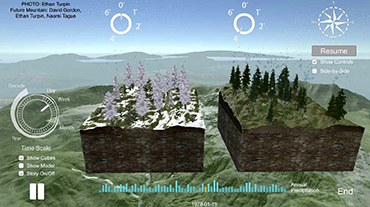
Abstract
As climate warms, the complex interactions between forests and water also change - and these changes can transform our landscapes. In the Western US, we have already seen increased fire severity, drought, floods, and widespread forest mortality.
Naomi's TagueTeamLab develops a widely used mechanistic model, RHESSys, that simulates interactions among water, carbon, soils and vegetation at scales from a forest plot to a watershed- We use this model to understand our changing landscapes and to predict future changes. Recently she has been collaborating with an artist, Ethan Turpin, and MAT graduate, David Gordon, to translate the data generated by RHESSys into meaningful visualization that can help the public, students and scientists themselves explore how water-trees and climate coevolve. This talk will present this work - and talk about possible future directions.
Bio
Christina Tague's research is focused on the interactions between hydrology and ecosystem processes and, specifically, how eco-hydrologic systems are altered by changes in land use and climate. Much of her work involves developing and using spatial simulation models to integrate data from multiple field-based monitoring studies in order to generalize results to larger watersheds. Reflecting that emphasis, she is one of the principal developers of the Regional Hydro-Ecologic Simulation System (RHESSys), an integrated model of spatially distributed carbon, water, and nitrogen cycling. RHESSys is designed to provide science-based information about spatial patterns of ecosystem health and vulnerability in terms of water quantity and quality. Professor Tague is currently modeling the impacts of climate change on stream-flow patterns in the western United States and examining how urbanization alters drainage patterns and associated biogeochemical cycling in watersheds in Baltimore, Maryland, and Southern California.
Christina Naomi Tague's Web Site
See video recording of the talk here

